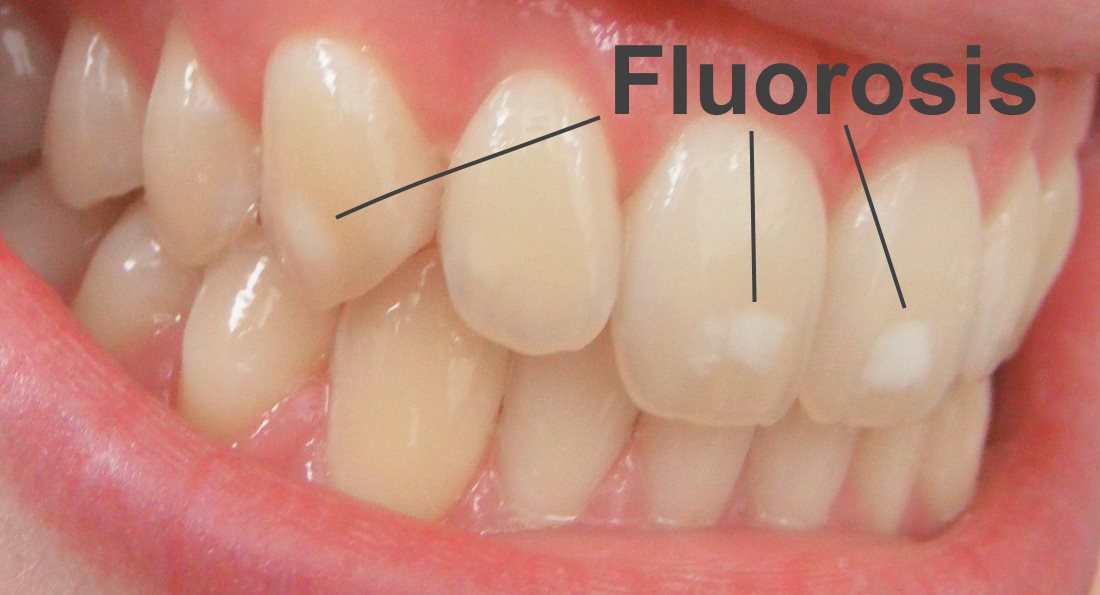All About White Lines on Teeth (Fluorosis And Craze Lines)

We all want a bright, confident smile. White lines on teeth can cause social anxiety and concern for one’s dental health. In most cases, these lines will not lead to any serious health issues. Although they cannot always be permanently cured, they can be treated and at least temporarily erased through simple procedures.
White lines on teeth can have a variety of causes. Each cause involves the enamel on your teeth, one of the hardest substances on Earth. The main causes are fluorosis and craze lines. In both cases, the treatment is the same.
Fluorosis
Mild fluorosis causes white lines on teeth when excess fluoride consumption causes a lack of calcium in your tooth enamel. This only happens when your permanent teeth are developing in childhood, but the effects can remain into adulthood. In more severe cases teeth will appear brown and worn down. Fluorosis is extremely common, affecting over half of post-adolescent Americans.
The number one source in the USA is fluoridated water, accounting for 40% of all cases of fluorosis. Other sources include swallowing toothpaste or mouthwash. These are more prevalent with children than with adults. Predictably, fluorosis can be prevented by lowering a child’s intake of fluoride. Have children spit and rinse all toothpaste and mouthwash out of your mouth and check the fluoridation level of your local water source.
Craze lines
Another cause of white lines on teeth are fine cracks in your tooth enamel, called craze lines. This is rarely more than a cosmetic problem. It is similar to the intentionally-formed fine cracks sometimes found on the glaze of ceramic pottery. These lines in pottery are also called craze lines. Dental craze lines are caused by trauma to your teeth. This trauma can mean grinding your teeth, especially during sleep or stressful situations. Trauma can also come from sudden temperature changes, regular chewing, biting a hard object, or an accident.
Craze lines generally present no problems. However, they can serve as host to bacterial growth, leading to plaque and eventually hardened white tartar. Craze lines cannot be removed, but they can be treated. Tartar buildup can be managed by regular visits to your dentist for professional cleaning.
Treatment
Tooth Whitening
Tooth whitening can help conceal the existence of both fluorosis and craze lines. Whitening, or bleaching, does not remove or heal the craze lines, nor does it repair your tooth enamel. Whitening simply removes any discoloration caused by craze lines or fluorosis, giving your teeth a uniform color. There are many options for tooth whitening available to you.
Leave it to a pro
The most effective way to whiten your teeth is to let your dentist do it. Dentists use chemical solutions that are much stronger than anything available to the public. It will probably cost a few hundred dollars, but results can be noticed in less than an hour. Although this is the most effective method, depending on your teeth, it may not always produce snow-white results. Nevertheless, it is the most effective way to remove white lines on teeth.
Do it yourself
Home tooth whitening kits are much cheaper than getting your teeth whitened by a dentist. They come in various forms, including strips, gels, and specialized kits. Each kit takes around twenty or thirty minutes to use once or twice a day, and are usually meant to be used from one week to one month.
An affordable, effective and natural option is Active Wow Teeth Whitening Charcoal Powder Natural. This is good for sensitive teeth because it does not contain harsh peroxides. Simply dab a bit of the powder on a wet toothbrush and gently brush like normal. This is not meant for extended use and cannot replace normal toothpaste.
To prevent the return of white lines on teeth, avoid coffee, red wine and tobacco as much as possible. These can stain craze lines and fluorosis damage different shades than the rest of your teeth.
Veneers
Veneers improve the aesthetics of your teeth and protect them from damage. This is a very effective but costly way to address white lines on teeth caused by either craze lines or fluorosis. Veneers are made either of dental composite resin or porcelain. Either way, they can only be put in by a dentist. Consult yours if you think this method is for you.
Conclusion
Prevention is always the best strategy to avoid unsightly dental abnormalities such as white lines on teeth. Always floss daily, brush two or three times a day and use a good mouthwash. Avoid junk food and avoid trauma to your teeth, including gnashing or clenching. Check how much fluoride you are ingesting. Your dentist should know the fluoridation level of your local water. Ensure all mouthwash and toothpaste is rinsed out of your mouth and not swallowed. White lines on teeth are generally harmless, but if they persist after home whitening, consider consulting your dentist.
